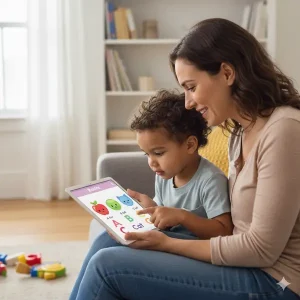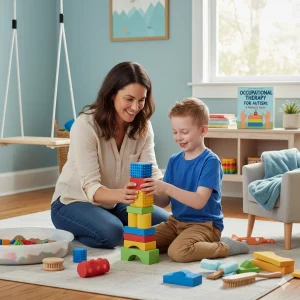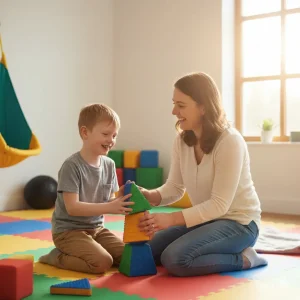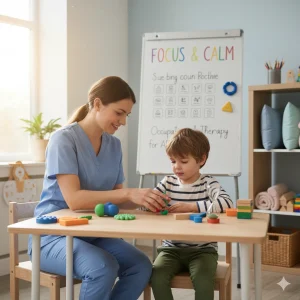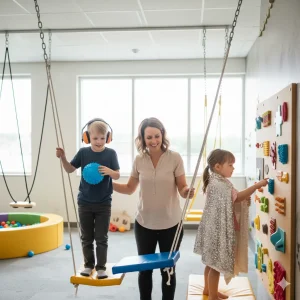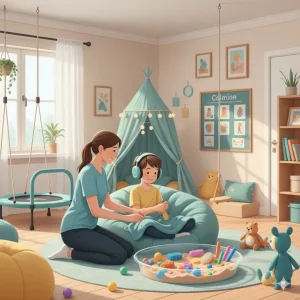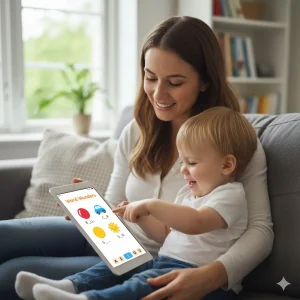How to Know If Your Child’s Speech Delay Needs Professional Support
Last Updated: October 13, 2025
“Why is my 4-year-old’s speech still unclear?” — if you’ve asked yourself this question, you’re not alone. Many parents worry when their preschooler’s words are hard to understand, especially compared to other kids their age. While some speech differences are perfectly normal, ongoing speech delay or unclear speech in 4-year-olds can sometimes signal the need for extra support.
At age four, children are expected to reach key speech milestones and be mostly understood by unfamiliar listeners. But if your child struggles with articulation, has frequent mispronunciations, or gets frustrated because others can’t follow what they say, it may be time to learn when professional help is recommended.
Free Speech Help for Kids
Concerned about speech delays? Book a free consultation with our expert speech therapist and get guidance tailored to your child’s needs.
What is a Speech Delay in Children?
A speech delay happens when a child has difficulty producing sounds or words clearly, even though their understanding of language may be age-appropriate. In simple terms, the child knows what they want to say, but their ability to express it through speech is not developing as expected. This is different from a language delay, where the challenge is not just how the child speaks, but also how they understand and use words, sentences, and grammar.
Parents often notice a speech delay when their child’s speech clarity makes it hard to understand what they are saying. For example, a 4-year-old might talk a lot, but their words may still be jumbled, mispronounced, or only understood by close family members. This can point to an articulation delay—when a child struggles to correctly produce specific sounds (like “r,” “s,” or “ch”). In some cases, it could be a phonological disorder, where a child uses the wrong sound patterns across many words.
Professionals often measure speech intelligibility, which means how well others can understand a child’s speech. By age four, most children should be understandable to unfamiliar listeners about 90% of the time. When clarity is much lower, it may suggest an ongoing concern.
Some children also use common phonological processes—patterns that simplify speech—such as:
- Fronting: saying “tat” instead of “cat”
- Stopping: saying “tun” instead of “sun”
- Cluster reduction: saying “pane” instead of “plane”
While these are typical at younger ages, if they persist beyond age four, they may signal the need for professional support.
A clear understanding of the difference between speech delay and language delay helps parents decide whether their child’s challenges are part of normal development or whether it’s time to consult a speech-language pathologist (SLP) for evaluation.
What is a Speech Delay in Children?
A speech delay means that a child is not developing their speaking skills at the expected pace for their age. Simply put, the child knows what they want to say, but getting the sounds and words out clearly is harder than it should be. This is different from a language delay, where the challenge goes beyond speech sounds and affects how a child understands words, builds sentences, or communicates ideas.
Parents often notice a speech delay when speech clarity in children is a concern. For example, a four-year-old may speak a lot but still be difficult to understand, even for close family members. In these cases, the child may be experiencing an articulation delay—trouble pronouncing certain sounds like “r,” “s,” or “ch.” Another possibility is a phonological disorder, where the child uses incorrect sound patterns across many words, making their speech harder to follow.
Specialists often talk about speech intelligibility, which means how well others can understand what a child says. By age four, most children should be understood almost all the time by people outside their family. If their speech is still unclear, it could be a sign to look more closely at what’s happening.
Children also use what are called phonological processes—shortcuts in speech that are normal at younger ages but should fade with development. Some common examples include:
- Fronting – saying “tat” instead of “cat”
- Stopping – saying “tun” instead of “sun”
- Cluster reduction – saying “pane” instead of “plane”
These patterns are part of typical development when children are toddlers, but if they continue past age four, they may signal the need for extra support.
Understanding the difference between a speech delay and a language delay gives parents a clearer picture of what’s typical and what might need professional attention. Early recognition can help ensure your child receives the right support at the right time.
Speech Milestones Parents Should Expect by Age 4
By the age of four, most children should be speaking in full sentences and sharing their thoughts with growing confidence. At this stage, speech clarity in children becomes very important, because unfamiliar listeners—not just parents—should be able to understand what the child is saying. Experts often use the term speech intelligibility to measure this. By age four, children are expected to be understood at least 90% of the time, even by people outside the family.
When a child struggles to reach these expectations, it may point to an articulation delay or a possible phonological disorder. For example, some sounds like “p,” “b,” “m,” “k,” and “g” are usually mastered early, while trickier sounds like “r,” “l,” “s,” “sh,” and “ch” may take a little longer to develop. If a child continues to replace or drop these sounds, their speech may still feel unclear to teachers, peers, or extended family.
It’s also common for children to use certain phonological processes—patterns that simplify words—during the preschool years. Saying “tat” instead of “cat” (fronting), “tun” instead of “sun” (stopping), or “pane” instead of “plane” (cluster reduction) are all typical at age two or three. But if these patterns continue past age four, it can signal the need for a professional opinion.
Parents should also pay attention to how their child handles conversations. A four-year-old should be able to:
- Tell short stories about their day
- Answer simple “who,” “what,” and “where” questions
- Use correct word endings, like plurals and past tense
- Be mostly understood without frequent repetition
Knowing these speech milestones helps families recognize when their child is on track, and when to seek extra guidance. If your child’s speech is still unclear at four, don’t panic—but do consider whether an evaluation by a speech-language pathologist (SLP) could provide reassurance and the right next steps.
Red Flags That Suggest Professional Help May Be Needed
Every child develops at their own pace, but some signs point to the need for a closer look. If you notice these red flags in your preschooler, it may be time to consult a speech-language pathologist (SLP) for evaluation and support:
- 4-year-old speech not clear but talks a lot – Your child may have plenty to say, but if their words are still hard to understand, this could suggest an underlying issue.
- Child hard to understand by unfamiliar listeners – Parents often get used to their child’s speech patterns, but teachers, relatives, or other children may struggle to follow what your child is saying.
- Mispronunciations persist beyond typical age – Substituting or dropping sounds like “s,” “sh,” “ch,” or “r” after the age of four can point to an articulation delay or phonological disorder.
- Frustration or behavior issues due to not being understood – Children who are repeatedly misunderstood may become upset, withdraw socially, or act out.
- Regression or plateau in speech skills – If your child stops making progress, or loses skills they previously had, it’s a strong sign to seek professional input.
Other concerns that may require attention include possible childhood apraxia of speech, where a child has difficulty planning and coordinating the movements needed for speech, or frequent ear infections that can affect hearing and speech development. A hearing screening is often recommended when unclear speech persists, to rule out hearing loss as a contributing factor.
Recognizing these signs early can make a big difference. With timely support, children often gain speech clarity faster and with less frustration, building both their skills and their confidence.
Common Causes of Unclear Speech in Preschoolers
When a child’s speech is still unclear at age four, parents often wonder what’s behind the difficulty. Understanding the most common causes can help you know when to wait, when to practice at home, and when to seek professional guidance.
Articulation Disorder vs. Phonological Disorder
An articulation disorder happens when a child struggles to physically produce certain sounds, such as “r,” “s,” or “ch.” For example, they might say “wabbit” instead of “rabbit.” In contrast, a phonological disorder is more about patterns. Instead of just one tricky sound, a child may replace or simplify whole groups of sounds, such as saying “tat” for “cat” or “pane” for “plane.” Knowing whether it’s an articulation issue or a phonological delay helps speech-language pathologists (SLPs) choose the right therapy approach.
Hearing Loss or Ear Infections
Sometimes unclear speech is linked to ear infections and unclear speech development. Frequent ear infections can temporarily reduce hearing, making it hard for children to pick up on the correct sounds. Even mild hearing loss may prevent a child from distinguishing similar sounds, which affects their speech clarity. That’s why many SLPs recommend a hearing screening if a child’s speech is still difficult to understand at age four.
Tongue Tie and Oral-Motor Issues
A tongue tie or other oral-motor issue can also affect how a child moves their lips, tongue, and jaw to form sounds. While not every child with a tongue tie develops speech problems, some may have difficulty with clarity and articulation. Oral-motor weakness or coordination challenges can make it harder to produce clear, fluent speech.
Bilingual 4-Year-Old Speech Unclear — Normal or Not?
For families raising children in more than one language, it’s common to worry: Is unclear speech normal in a bilingual 4-year-old? In many cases, the answer is yes. Bilingual children may mix sounds or switch between languages as they learn. This is a normal part of development and doesn’t necessarily mean there’s a disorder. However, if a bilingual child shows the same red flags as monolingual peers—such as frustration, regression, or very low speech intelligibility—it’s worth consulting an SLP.
Other Factors
In some cases, more complex conditions such as childhood apraxia of speech (a motor planning disorder) may be responsible. Understanding whether it’s apraxia vs. phonological delay is critical, as treatment strategies differ. Early evaluation ensures that children receive the right type of therapy tailored to their specific needs.
Common Causes of Unclear Speech in Preschoolers
When a preschooler’s speech is still unclear, parents often feel concerned and wonder what might be going on. In most cases, the reasons are not about intelligence or effort, but rather about how speech sounds are learned and produced. Understanding the most common causes can help you decide whether your child simply needs more time or if professional support is the right step.
Articulation Disorder vs. Phonological Disorder
One common cause of unclear speech is an articulation disorder, where a child struggles with producing specific sounds correctly. For example, saying “wabbit” instead of “rabbit” shows difficulty with the “r” sound. On the other hand, a phonological disorder is more about sound patterns. A child may use rules that simplify speech, such as replacing all “k” sounds with “t,” so “cat” becomes “tat.” Knowing whether it’s apraxia vs phonological delay or a simple articulation issue matters because each requires a different therapy approach.
Hearing Loss or Ear Infections
Frequent ear infections and unclear speech often go hand in hand. If a child can’t consistently hear sounds, it’s harder to reproduce them clearly. Even mild hearing loss can affect how well a child learns to distinguish between sounds like “s” and “sh.” This is why many speech-language pathologists recommend a hearing screening if unclear speech continues beyond age four. Treating hearing concerns early can prevent long-term speech difficulties.
Tongue Tie and Oral-Motor Issues
Some children have physical challenges that make speech harder. A tongue tie (restricted tongue movement) or oral-motor weakness may limit how well the lips, tongue, and jaw can coordinate to produce clear speech. While not every child with a tongue tie develops a speech problem, it can contribute to ongoing articulation difficulties if left unaddressed.
Bilingual 4-Year-Old Speech Unclear — Normal or Not?
Parents raising children with more than one language often worry that bilingualism causes unclear speech. In reality, mixing sounds or switching between languages is usually a normal part of development. A bilingual 4-year-old with unclear speech may simply be sorting out the rules of both languages. However, if the child shows persistent speech intelligibility issues, frustration, or a lack of progress compared to peers, it’s best to check with an SLP to rule out an underlying disorder.
When to See a Speech-Language Pathologist (SLP)
Many parents wonder, “When should I worry about my 4-year-old’s speech clarity?” While some variation is normal, a child who is still very difficult to understand by age four may benefit from an expert evaluation. That’s where a speech-language pathologist (SLP) comes in.
An SLP specializes in identifying whether unclear speech is part of normal development or a sign of a speech sound disorder. If you’ve been asking yourself, “Does my 4-year-old need speech therapy?”, a professional evaluation can provide clear answers and peace of mind.
What Happens in a Speech Evaluation?
Parents are often curious about what happens in a speech evaluation. During the session, the SLP will:
- Talk and play with your child in a relaxed, child-friendly setting.
- Listen carefully to your child’s pronunciation, sentence use, and speech intelligibility.
- Check which sounds are clear, which are missing, and whether patterns like phonological processes (such as saying “tat” for “cat”) are still present.
- Ask about your child’s medical history, hearing, and development, since factors like frequent ear infections can affect clarity.
- Provide feedback on whether your child’s speech is on track, delayed, or in need of therapy.
Why Early Intervention Matters
If an SLP finds concerns, they may recommend speech therapy for 4-year-olds. Early intervention often leads to faster progress, because preschoolers are highly responsive to play-based therapy. The earlier support begins, the sooner children can build confidence, reduce frustration, and develop clear communication skills.
Seeing a speech-language pathologist doesn’t always mean your child will need long-term therapy. Sometimes, reassurance and simple home strategies are enough. But if therapy is recommended, you’ll have a structured plan to help your child succeed.
What Happens in Speech Therapy for Preschoolers?
If your child needs extra help, you might be wondering what speech therapy for 4-year-olds actually looks like. Many parents imagine worksheets or drills, but in reality, therapy sessions are fun, engaging, and built around play.
Play-Based Learning
A speech-language pathologist (SLP) uses play-based activities to capture a child’s attention while targeting specific sounds. Games with toys, picture cards, and storytelling are designed to keep therapy enjoyable while still building important skills.
Minimal Pairs and Sound Shaping
For children who mix up sounds, SLPs often use minimal pairs—words that differ by just one sound, like “cat” and “tat.” Practicing these helps children notice and correct their errors. Another strategy is sound shaping, where an SLP gradually teaches a difficult sound by building it from an easier one. For example, turning a “t” into an “s” step by step.
Parent Involvement Matters
Therapy doesn’t stop when the session ends. Parents play a big role in reinforcing progress. SLPs often provide speech therapy activities at home, such as reading aloud together, practicing new sounds during daily routines, or using short games that strengthen speech skills. Consistency at home is what helps children improve the fastest.
Building Clarity and Confidence
The main goal of therapy is to improve speech clarity at home and school, so children can be understood by teachers, friends, and family. As clarity grows, so does a child’s confidence and willingness to engage in conversations.
By combining professional guidance with parent involvement, speech therapy for preschoolers is both effective and empowering. The earlier children get support, the easier it becomes to correct speech patterns and set them up for long-term success.
Home Tips to Support Speech Clarity
Parents play an important role in helping children become clear and confident speakers. Alongside professional guidance, there are many simple ways to support your child’s progress at home. These strategies don’t require special tools—just time, patience, and a playful attitude.
Reading Aloud Every Day
Reading picture books aloud is one of the best ways to expose your child to new sounds, words, and sentence structures. Pause occasionally to let your child repeat simple words or point to familiar objects. This builds vocabulary while gently reinforcing clear pronunciation.
Modeling Sounds Naturally
When your child mispronounces a word, resist the urge to correct them harshly. Instead, repeat the word back the right way in a calm, encouraging tone. For example, if your child says “tat” for “cat,” you might reply, “Yes, that’s a cat.” This natural modeling helps children learn without feeling pressured.
Short, Fun Drills
You can also practice home exercises to improve articulation for 4-year-olds through short and playful drills. Use rhyming games, silly sound repetitions, or tongue twisters made age-appropriate. Keep these sessions brief—just a few minutes—to maintain interest and avoid frustration.
Learning Through Play
Simple games like “I Spy,” board games, or singing along to songs can make speech practice enjoyable. Play creates a relaxed environment where children are more willing to try new sounds and repeat tricky words.
Build Confidence, Reduce Frustration
The most important goal is to help your child feel successful. Celebrate small wins, like correctly pronouncing a new sound or being understood by someone outside the family. Avoid drawing too much attention to mistakes. Confidence is a key ingredient in speech progress, and reducing frustration makes practice more effective.
By weaving these simple activities into daily life, parents can turn everyday moments into opportunities for growth. Combined with professional support, these home strategies set the stage for clearer, more confident communication.
Conclusion
Every child grows at their own pace, and some speech differences at age four are normal. But if speech clarity in 4-year-olds is still a big struggle, it may be time to act. An early check with a speech-language pathologist (SLP) can give clear answers and the right plan. With early help, kids often improve faster, speak more clearly, and feel more confident. If you are searching for “speech therapy near me,” don’t wait. Explore trusted speech therapy services today and give your child the support they need to be understood and thrive.
Frequently Asked Questions:
1. Why is my 4-year-old’s speech still unclear?
A 4-year-old’s speech may still be unclear for several reasons. Some children have an articulation delay, where they struggle to produce certain sounds correctly. Others may have a phonological disorder, where sound patterns are simplified, making speech hard to understand. Frequent ear infections or mild hearing loss can also affect how children learn and copy sounds. While some variation is normal, if your child talks a lot but is still hard to understand, it’s a good idea to check with a speech-language pathologist (SLP).
2. When should I worry about my 4-year-old’s speech clarity?
It’s time to be concerned if your child is not understood by teachers, relatives, or unfamiliar listeners. By age four, most children should be about 90% understandable. If your child continues to mispronounce many sounds, shows little progress, or becomes frustrated when others can’t understand them, these are red flags. Early evaluation ensures your child doesn’t fall behind socially or academically.
3. What sounds should a 4-year-old be able to say?
By age four, children typically master simpler sounds such as p, b, m, k, g, f, and t. They may still be learning harder sounds like r, l, s, sh, ch, and th, which often develop later. If your child continues to replace or skip early sounds, or uses speech patterns like saying “tat” for “cat,” it may point to an articulation or phonological delay that needs attention.
4. Does my 4-year-old need speech therapy?
You might be asking, “Does my 4-year-old need speech therapy?” The answer depends on how much their speech affects daily life. If your child’s speech clarity is much lower than other kids their age, if they are difficult to understand outside the family, or if their speech seems to have stopped improving, therapy may help. An SLP evaluation is the best way to decide whether professional support is needed.
5. What happens in a speech evaluation?
During a speech evaluation, the speech-language pathologist uses play and conversation to assess your child’s skills. They check which sounds are clear, which are missing, and whether phonological processes (like fronting or stopping) are still present. The SLP may also ask about medical history, hearing, and development. At the end, they explain whether your child’s speech is within normal limits or if speech therapy for 4-year-olds would be beneficial.
6. Can ear infections cause unclear speech?
Yes. Frequent ear infections and unclear speech often go together. Ear infections can cause temporary hearing loss, making it harder for children to hear sounds accurately. If a child cannot hear differences between sounds like “s” and “sh,” they may mispronounce them. This can delay speech clarity. A simple hearing screening can check whether this is part of the problem.
7. Is unclear speech normal in bilingual 4-year-olds?
For bilingual children, some speech mixing is normal. A bilingual 4-year-old with unclear speech may switch between languages or confuse sound rules while learning. This doesn’t always mean there’s a disorder. However, if your child is unclear in both languages, shows frustration, or doesn’t improve with time, it’s worth getting an evaluation to rule out apraxia vs phonological delay or other concerns.
8. How can I improve my 4-year-old’s speech clarity at home?
Parents can make a big difference with simple daily activities. Home exercises to improve articulation for 4-year-olds include reading aloud, repeating words clearly, and turning practice into short games. Modeling correct sounds—by repeating your child’s word the right way without pressure—is also very effective. Singing, rhyming games, and picture books are fun ways to build skills. The key is keeping practice short, playful, and positive to reduce frustration.
9. How long does speech therapy for 4-year-olds take?
The length of speech therapy for preschoolers depends on the child’s needs. Some children make progress in just a few months, while others with more complex issues may need longer. Factors like the type of delay, the child’s motivation, and consistent home practice all affect how quickly improvement happens. Starting early usually means faster results and fewer long-term difficulties.
10. Where can I find speech therapy near me?
If you’ve been searching for “speech therapy near me”, start by asking your pediatrician or your child’s school for recommendations. Many communities also have early intervention programs for preschoolers. You can also look online for licensed speech-language pathologists in your area. Choosing local therapy ensures convenience and helps your child build regular practice routines.
About the Author:
Shravanaveena Gajula
M.Sc ., Speech and Language Pathology (5+ years of experience)
Shravanaveena Gajula is a dedicated Speech-Language Pathologist with a BASLP and an M.Sc in Speech and Language Pathology. With experience spanning multiple settings, including Wellness Hub , Veena specializes in a wide range of disorders from developmental issues in children to speech and language assessments in adults. Her expertise includes parent counseling, managing speech sound and fluency disorders, and creating individualized therapy programs. Veena is also PROMPT certified and an author of several insightful blogs on speech and language pathology, aiming to educate and assist caregivers in supporting their loved ones.
Book your Free Consultation Today
Parent/Caregiver Info:
Client’s Details:
* Error Message
